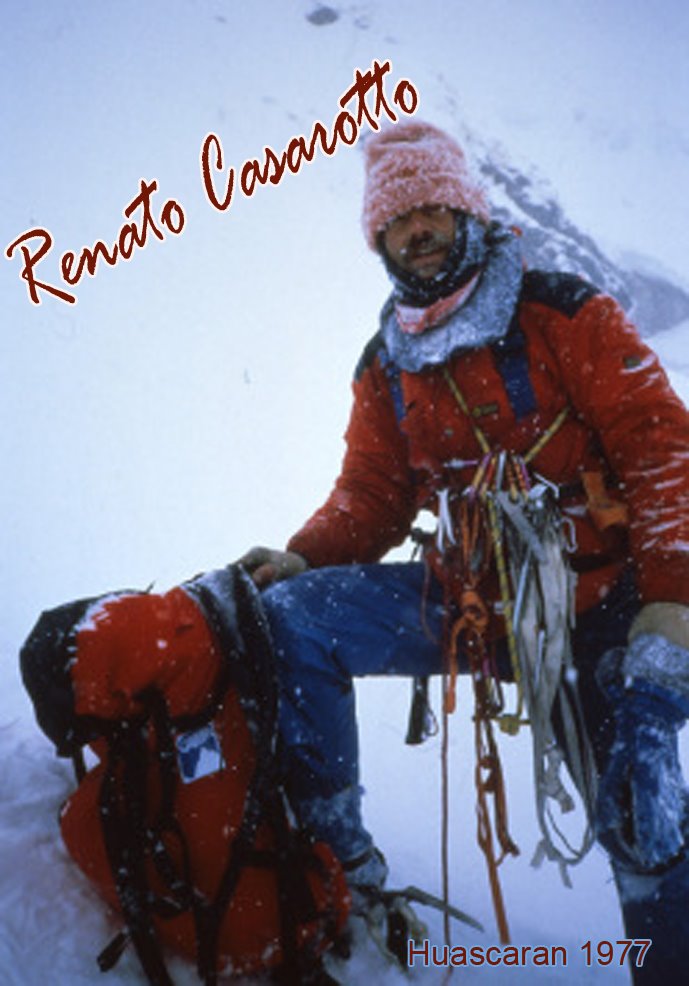He was born on May 15, 1948. Casarotto, an Italian climber, ascended Broad Peak North (7,490 m) alone in 1983 (first ascent) and Gasherbrum II in 1985. Lo triste died young in 1986 in the K2 massif at the age of 38. Casarotto was famous for his challenging winter solitary ascents in the dolomites and on Mont Blanc, he also opened new routes in Patagonia, Peru and the Karakorum. Sadly he died after an attempt to climb the exposed southwestern wall of K2, the magic line route, falling into a crevasse near base camp.
RENATO CASAROTTO said that: Solitary mountaineering is the highest aspiration of a climber.

Casarotto: limiting risk is a fundamental factor, a problem that requires a constant self-insurance technique, which guarantees safety in every situation. Since the unexpected is always possible and only a little to make us fall, no matter how strong and prepared we feel... Certainly, the destiny of our lives, for a good ninety percent, depends on ourselves.
Casarotto on the north face of the northern peak of Huascarán remained alone for 17 days and overcame extreme difficulties in all terrains: ice, rock, mixed, storm, snowfall, both in free climbing and artificial climbing. Casarotto discovered the north face of Huascaran N in 1975, when the Riviera del Brenta expedition attempted to climb the south face of Nevado Huandoy S, located just in front of the north peak of Huascarán. Some reviews of the climb: On June 5 he begins to equip the first branch, on June 7 he says goodbye to the porters and begins the attack in bad weather.
On June 19, he made a drastic decision due to weight problems and high-risk exhaustion, but it was the only way to shorten the times: Abandon the curtain, down bag, gaiters, and some of the climbing equipment. Now it is absolutely necessary to reduce the bivouac days, considering only what is necessary at an extreme level and leaving the glacier as soon as possible.
He enters a channel continually interrupted by difficult rocky jumps, of which he cannot see the end. At night he settles inside a weak ice cave, eats his last meal and prepares to spend the first cold night without bivouac material (with the clothes he was wearing).
June 20, the channel compromises him with ice flows that give no respite, but the summit is close and this helps him continue. At night, as you prepare the open space for the final camp on the wall, you may exchange shouts with three Englishmen, probably on the west ridge on your right side, which gives you strength to continue. June 21, overcome the last difficult rope length of free climbing grade V, with crampons on, then take hard green ice to make safe passage on the snow in thick fog conditions; Finally it reaches the North summit (6655 m.). Because of the glare of the glacier he needs his mountain lens, he opens his backpack and realizes that his lenses are unusable (they are useless), he takes some photos, then quickly descends to field II (Garganta), which separates the two peaks of Huascarán. Just below, he digs a cave in the snow and sits in the last painful bivouac with wet clothes on, because he left his sleeping bag and bivouac two days earlier to avoid the weight. June 22, slowly descends with extreme exhaustion problems heading west with little reference to the normal route. The porter César Castromonte, who had been waiting 3 days before in the moraine field with food and shelters, at approximately 10:00 am sees Casarotto descend, at which point he had the idea of laying an orange sleeping bag on a large rock to that Casarotto has as a reference the address to go to. With that reference Casarotto heads to meet Cesar, and Cesar himself goes up to give him help and take him to the camp; Cesar gives him all the attention necessary for his recovery, after an hour of rest and due to vision problems that he could not see, they descend to the town of Musho (in this section Cesar helps Casarotto by holding his hand), where they take a taxi to the town of Yungay to spend the night in a hotel. June 23, he returns to the Llanganuco valley to meet his wife and they return together to Huaraz.
– Author: Porfirio Cacha –